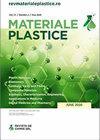Flexural Modulus Enhancement and Minimization of Printing Time and Part Weight for PET-G, Using Taguchi-GRA-TOPSIS Techniques
IF 0.6
4区 材料科学
Q4 MATERIALS SCIENCE, MULTIDISCIPLINARY
引用次数: 0
Abstract
Fused deposition modeling (FDM) is becoming the most promised additive manufacturing (AM) process in recent years due to the evident benefits, such as high design flexibility, low cost, friendly and economically use. The current study considers an optimization of four different FDM parameters varied in three levels, as layer thickness (0.17 mm, 0.25 mm and 0.33 mm), infill density (25, 50 and 75%), shell thickness (0.8 mm, 1.2 mm and 1.6 mm) and raster angle (0o, 30o and 60o) with an objective to reduce printing time, part weight and to enhance flexural modulus using Polyethylene Terepthalate - glycol modified (PET-G) material. Mono optimization of FDM input parameters has been done using signal to noise ratio method obtained from Taguchi�s L9Orthogonal Array (OA) and multi response optimization is applied through Grey Relational Analysis (GRA) and technique of order preference similar to ideal solution (TOPSIS) techniques. The response or its criteria weightages are calculated using Shanon�s entropy and CRITIC method which gives different weightages for the considered responses. Printing time ranks top with 37% from entropy method followed by flexural modulus with 36% and part weight ranks last with 28%. Flexural modulus ranks tops with 43% followed by part weight with 29% and printing time takes last position with 28% weightage.The ranking of alternatives from GRA- entropy and GRA- CRITIC methods are similar by recommending A1B1C1D1 (0.17 mm layer thickness, 25% infill density, 0.8 mm shell thickness and 0� raster angle) but TOPSIS-entropy and TOPSIS - CRITIC methods suggested different parameter combination A2B3C1D2 (0.25 mm layer thickness,75% infill density, 0.8 mm shell thickness and 30� raster angle). From all the four different methods adopted for optimization, the parameter setting obtained from level total suggests A2B1C1D2 (0.25 mm layer thickness, 25% infill density, 0.8mm shell thickness and 30� raster angle) and completely opposite to the ranking of alternatives. The carried - out confirmation trials carried out validated the optimized settings resulted from different methods. Infill density is found to be the most significant factor as compared to other input factors over the output assessed parameters.利用田口GRA-TOPSIS技术提高PET-G的弯曲模量并最大限度地减少印刷时间和零件重量
近年来,由于具有高设计灵活性、低成本、友好和经济使用等明显的优势,熔融沉积建模(FDM)正成为最有前途的增材制造(AM)工艺。目前的研究考虑了四种不同的FDM参数在三个层次上的优化,即层厚度(0.17 mm, 0.25 mm和0.33 mm),填充密度(25%,50%和75%),外壳厚度(0.8 mm, 1.2 mm和1.6 mm)和光栅角度(00,300和600),目的是减少打印时间,零件重量并提高使用聚对苯二甲酸乙二醇酯改性(PET-G)材料的弯曲模量。采用田口正交阵列(Taguchi’s L9Orthogonal Array, OA)的信噪比法对FDM输入参数进行单响应优化,并通过灰色关联分析(GRA)和类似于理想解(TOPSIS)的顺序偏好技术对FDM输入参数进行多响应优化。使用香农熵和批评家方法计算响应或其标准权重,该方法为考虑的响应提供不同的权重。打印时间以37%的熵值排名第一,其次是弯曲模量(36%),最后是零件重量(28%)。弯曲模量以43%排名第一,其次是零件重量29%,打印时间以28%的重量排名最后。GRA-熵法和GRA- CRITIC法的选择排序相似,均推荐A1B1C1D1 (0.17 mm层厚、25%填充密度、0.8 mm壳厚、0°栅格角),但TOPSIS-熵法和TOPSIS- CRITIC法建议不同的参数组合A2B3C1D2 (0.25 mm层厚、75%填充密度、0.8 mm壳厚、30°栅格角)。从所采用的四种不同的优化方法中,从水平总量中得到的参数设置为A2B1C1D2(层厚0.25 mm,填充密度25%,壳厚0.8mm,栅格角度30°),与备选方案的排名完全相反。所进行的确认试验验证了不同方法得到的优化设置。与其他输入因素相比,在输出评估参数中,填充密度被发现是最重要的因素。
本文章由计算机程序翻译,如有差异,请以英文原文为准。
求助全文
约1分钟内获得全文
求助全文
来源期刊

Materiale Plastice
MATERIALS SCIENCE, MULTIDISCIPLINARY-
CiteScore
1.40
自引率
25.00%
发文量
99
审稿时长
6-12 weeks
期刊介绍:
Materiale Plastice, abbreviated as Mater. Plast., publishes original scientific papers or guest reviews on topics of great interest.
The Journal does not publish memos, technical reports or non-original papers (that are a compiling of literature data) or papers that have been already published in other national or foreign Journal.
 求助内容:
求助内容: 应助结果提醒方式:
应助结果提醒方式:


